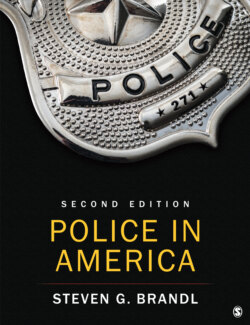Читать книгу Police in America - Steven G. Brandl - Страница 120
На сайте Литреса книга снята с продажи.
Main Points
ОглавлениеMost police departments today are managed and structured in accord with the five principles of bureaucracies: (1) division of labor, (2) hierarchy of authority, (3) rules, (4) impersonality of relationships, and (5) selection and promotion based on competence.
There is a clear reflection of the military in police departments today, as evidenced by the command and control orientation, emphasis on discipline, top-down chain of command, rank structure, “war-like” mission, emphasis on training, uniforms, weapons, and even the tactics that are used. The war-like mission can have negative consequences for the police and the community.
Police departments are monopolies but still need to be accountable to citizens for the services they provide.
Police departments have many features and problems in common with agencies such as public schools; public assistance agencies (e.g., homeless shelters, welfare agencies); municipal courts; legal service offices; public health offices; and so forth. All of these agencies can be described as street-level bureaucracies.
Much of the task of police management can be accurately thought of as the management of police discretion.
Officers who work the streets and supervisors who manage the street cops do not necessarily have the same goals or priorities. However, there is also mutual dependence: Police officers can make work difficult for their supervisors and vice versa.
There are never enough resources in police departments, and there is a never-ending demand for services.
If the goals of an organization are difficult to determine and achieve, then it may also be difficult to specify what exactly constitutes good policing. The difficulty of adequately defining good policing has implications for all of police management.
Large and small police departments differ in several ways, including structural specialization and diversity of sworn officers. However, large and small departments do not differ greatly in terms of the technology that is used on the job.
Nearly all police departments have a patrol unit, although staffing levels may depend on the size of the department. Patrol is usually the largest unit in a department. To the extent that police departments are twenty-four-hour agencies, it is usually because patrol officers work both day and night shifts.
Common among police departments is a criminal investigation unit. The larger the department, the more specialization there is among investigators in the types of crimes investigated.
Other units within police departments may include special enforcement units (e.g., bomb squad, tactical enforcement); investigative units (e.g., sensitive crimes units); juvenile bureaus; communications units; internal affairs divisions; and crime analysis units.
In the United States, law enforcement is provided at the local, county, state, and federal government levels.
While most police departments in the nation are quite small, most police officers work in larger departments.
Most sheriff’s departments have more varied responsibilities than local police departments. These responsibilities include law enforcement, operation of a county jail, and court security. The amount of personnel and resources devoted to each task depends on the characteristics of the county.
Each state has a state law enforcement agency. Some states have a highway patrol and department of public safety; other states have state police.
There are approximately 1,700 other public law enforcement agencies in the United States that have special jurisdictions. The largest share of these agencies, about 750, consists of campus police departments serving colleges and universities.
The Clery Act requires institutions of higher education that participate in federal financial aid programs to keep and disclose information about crime on and near their campuses.
The primary law enforcement agencies of the federal government are located in the Department of Homeland Security (DHS) and the Department of Justice (DOJ). They include Customs and Border Protection; Immigration and Customs Enforcement; the Secret Service; the Federal Bureau of Investigation; the Transportation and Security Administration; the Bureau of Alcohol, Tobacco, Firearms and Explosives; the Drug Enforcement Administration; and the U.S. Marshals Service. There are a multitude of other federal agencies that have some law enforcement responsibilities and employ agents, investigators, and/or police.
